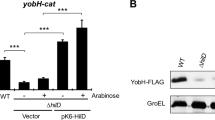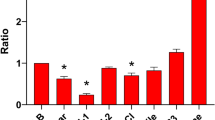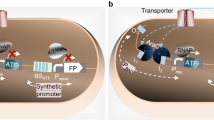Abstract
Systems allowing tightly regulated expression of prokaryotic genes in vivo are important for performing functional studies of bacterial genes in host-pathogen interactions and establishing bacteria-based therapies. We integrated a regulatory control circuit activated by acetyl salicylic acid (ASA) in attenuated Salmonella enterica that carries an expression module with a gene of interest under control of the XylS2-dependent Pm promoter. This resulted in 20–150-fold induction ex vivo. The regulatory circuit was also efficiently induced by ASA when the bacteria resided in eukaryotic cells, both in vitro and in vivo. To validate the circuit, we administered Salmonella spp., carrying an expression module encoding the 5-fluorocytosine–converting enzyme cytosine deaminase in the bacterial chromosome or in a plasmid, to mice with tumors. Induction with ASA before 5-fluorocytosine administration resulted in a significant reduction of tumor growth. These results demonstrate the usefulness of the regulatory control circuit to selectively switch on gene expression during bacterial infection.
This is a preview of subscription content, access via your institution
Access options
Subscribe to this journal
Receive 12 print issues and online access
$259.00 per year
only $21.58 per issue
Buy this article
- Purchase on Springer Link
- Instant access to full article PDF
Prices may be subject to local taxes which are calculated during checkout




Similar content being viewed by others
References
Hohmann, E.L., Oletta, C.A., Loomis, W.P. & Miller, S.I. Macrophage-inducible expression of a model antigen in Salmonella typhimurium enhances immunogenicity. Proc. Natl. Acad. Sci. USA 92, 2904–2908 (1995).
McKinney, J., Guerrier-Takada, C., Galan, J. & Altman, S. Tightly regulated gene expression system in Salmonella enterica serovar Typhimurium. J. Bacteriol. 184, 6056–6059 (2002).
Bumann, D. Regulated antigen expression in live recombinant Salmonella enterica serovar Typhimurium strongly affects colonization capabilities and specific CD4(+)-T-cell responses. Infect. Immun. 69, 7493–7500 (2001).
Ward, S.J., Douce, G., Figueiredo, D., Dougan, G. & Wren, B.W. Immunogenicity of a Salmonella typhimurium aroA aroD vaccine expressing a nontoxic domain of Clostridium difficile toxin A. Infect. Immun. 67, 2145–2152 (1999).
Huang, Y., Hajishengallis, G. & Michalek, S.M. Construction and characterization of a Salmonella enterica serovar typhimurium clone expressing a salivary adhesin of Streptococcus mutans under control of the anaerobically inducible nirB promoter. Infect. Immun. 68, 1549–1556 (2000).
Medina, E., Paglia, P., Rohde, M., Colombo, M.P. & Guzman, C.A. Modulation of host immune responses stimulated by Salmonella vaccine carrier strains by using different promoters to drive the expression of the recombinant antigen. Eur. J. Immunol. 30, 768–777 (2000).
Bateman, B.T., Donegan, N.P., Jarry, T.M., Palma, M. & Cheung, A.L. Evaluation of a tetracycline-inducible promoter in Staphylococcus aureus in vitro and in vivo and its application in demonstrating the role of sigB in microcolony formation. Infect. Immun. 69, 7851–7857 (2001).
Qian, F. & Pan, W. Construction of a tetR-integrated Salmonella enterica serovar Typhi CVD908 strain that tightly controls expression of the major merozoite surface protein of Plasmodium falciparum for applications in human vaccine production. Infect. Immun. 70, 2029–2038 (2002).
Pawelek, J.M., Low, K.B. & Bermudes, D. Bacteria as tumour-targeting vectors. Lancet Oncol. 4, 548–556 (2003).
Weissmann, G. Aspirin. Sci. Am. 264, 84–90 (1991).
Hennekens, C.H. Update on aspirin in the treatment and prevention of cardiovascular disease. Am. J. Manag. Care 8, S691–S700 (2002).
Yin, M.J., Yamamoto, Y. & Gaynor, R.B. The anti-inflammatory agents aspirin and salicylate inhibit the activity of I(kappa)B kinase-beta. Nature 396, 77–80 (1998).
Cebolla, A., Sousa, C. & de Lorenzo, V. Rational design of a bacterial transcriptional cascade for amplifying gene expression capacity. Nucleic Acids Res. 29, 759–766 (2001).
Suarez, A. et al. Stable expression of pertussis toxin in Bordetella bronchiseptica under the control of a tightly regulated promoter. Appl. Environ. Microbiol. 63, 122–127 (1997).
Cebolla, A., Sousa, C. & de Lorenzo, V. Effector specificity mutants of the transcriptional activator NahR of naphthalene degrading Pseudomonas define protein sites involved in binding of aromatic inducers. J. Biol. Chem. 272, 3986–3992 (1997).
Cebolla, A., Royo, J.L., De Lorenzo, V. & Santero, E. Improvement of recombinant protein yield by a combination of transcriptional amplification and stabilization of gene expression. Appl. Environ. Microbiol. 68, 5034–5041 (2002).
Clairmont, C. et al. Biodistribution and genetic stability of the novel antitumor agent VNP20009, a genetically modified strain of Salmonella typhimurium. J. Infect. Dis. 181, 1996–2002 (2000).
Yu, Y.A. et al. Visualization of tumors and metastases in live animals with bacteria and vaccinia virus encoding light-emitting proteins. Nat. Biotechnol. 22, 313–320 (2004).
Low, K.B. et al. Lipid A mutant Salmonella with suppressed virulence and TNFα induction retain tumor-targeting in vivo. Nat. Biotechnol. 17, 37–41 (1999).
Wei, M.Q. et al. Facultative or obligate anaerobic bacteria have the potential for multimodality therapy of solid tumours. Eur. J. Cancer 43, 490–496 (2007).
Toso, J.F. et al. Phase I study of the intravenous administration of attenuated Salmonella typhimurium to patients with metastatic melanoma. J. Clin. Oncol. 20, 142–152 (2002).
Medina, E. et al. Pathogenicity island 2 mutants of Salmonella typhimurium are efficient carriers for heterologous antigens and enable modulation of immune responses. Infect. Immun. 67, 1093–1099 (1999).
Tzschaschel, B.D., Guzman, C.A., Timmis, K.N. & de Lorenzo, V. An Escherichia coli hemolysin transport system-based vector for the export of polypeptides: export of Shiga-like toxin IIeB subunit by Salmonella typhimurium aroA. Nat. Biotechnol. 14, 765–769 (1996).
Medina, E., Guzman, C.A., Staendner, L.H., Colombo, M.P. & Paglia, P. Salmonella vaccine carrier strains: effective delivery system to trigger anti-tumor immunity by oral route. Eur. J. Immunol. 29, 693–699 (1999).
Pawelek, J.M., Low, K.B. & Bermudes, D. Tumor-targeted Salmonella as a novel anticancer vector. Cancer Res. 57, 4537–4544 (1997).
Nemunaitis, J. et al. Pilot trial of genetically modified, attenuated Salmonella expressing the E. coli cytosine deaminase gene in refractory cancer patients. Cancer Gene Ther. 10, 737–744 (2003).
Burns-Keliher, L., Nickerson, C.A., Morrow, B.J. & Curtiss, R., III. Cell-specific proteins synthesized by Salmonella typhimurium. Infect. Immun. 66, 856–861 (1998).
Miller, J.H. Experiments in molecular genetics. (Cold Spring Harbor Laboratory Press, Cold Spring Harbor, New York, 1972).
Author information
Authors and Affiliations
Contributions
J.L.R. and P.D.B. performed most of the experimental work and analysis of data, and contributed to experimental design. E.M.C. mapped the insertion of the regulatory module and constructed the strains bearing the expression module integrated into the aroC locus. A.C. initially designed the cascade expression system for use in eukaryotic cells. C.L. contributed to the in vivo work. E.S. and C.A.G. were responsible for experimental design, participated in the analysis of raw data and wrote the paper.
Corresponding author
Ethics declarations
Competing interests
A.C. is an employee of Biomedal S.L.
Supplementary information
Supplementary Text and Figures
Supplementary Figures 1–2, Supplementary Table 1, Supplementary Methods (PDF 381 kb)
Rights and permissions
About this article
Cite this article
Royo, J., Becker, P., Camacho, E. et al. In vivo gene regulation in Salmonella spp. by a salicylate-dependent control circuit. Nat Methods 4, 937–942 (2007). https://doi.org/10.1038/nmeth1107
Received:
Accepted:
Published:
Issue Date:
DOI: https://doi.org/10.1038/nmeth1107
This article is cited by
-
Applications of synthetic biology in medical and pharmaceutical fields
Signal Transduction and Targeted Therapy (2023)
-
Arginine deiminase produced by lactic acid bacteria as a potent anti-cancer drug
Medical Oncology (2023)
-
Ultrasound-controllable engineered bacteria for cancer immunotherapy
Nature Communications (2022)
-
Spatiotemporal control of engineered bacteria to express interferon-γ by focused ultrasound for tumor immunotherapy
Nature Communications (2022)
-
Optimized Doxycycline-Inducible Gene Expression System for Genetic Programming of Tumor-Targeting Bacteria
Molecular Imaging and Biology (2022)



